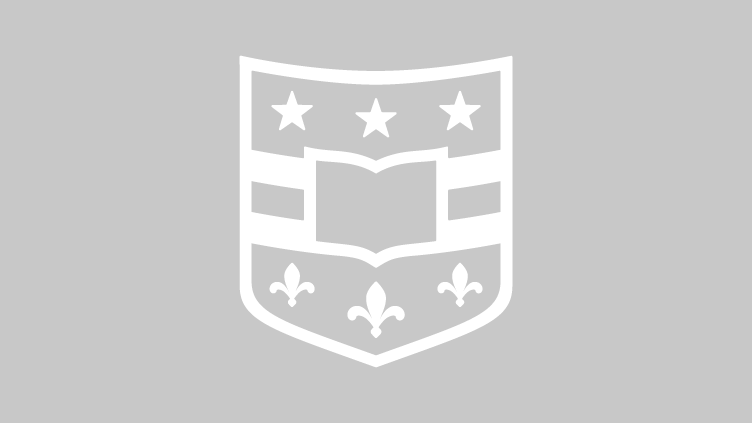Astrophysicists spot pulsed radiation from Crab Nebula that wasn’t supposed to be there
The VERITAS array of telescopes has detected pulsed gamma rays from the pulsar at the heart of the Crab Nebula that have energies far higher than the common theoretical models can explain. The finding is one of the most exciting in the telescope’s history, according to consortium members at Washington University in St. Louis.
Coping with climate change the topic of 2011 Robert M. Walker Distinguished Lecture Series
Charles F. Kennel, PhD, chair of the National Academy of Sciences’ Space Studies Board, will deliver the fourth annual Robert M. Walker Distinguished Lecture at 7 p.m. Wednesday, Oct. 19, in Room 100, Whitaker Hall, at Washington University in St. Louis. Kennel will discuss “Managing Climate Risk: Precarious Decades Ahead” during the free lecture that is open to the public.
WUSTL scientist wins prestigious Presidential Early Career Award
The White House announced Sept. 27 that Lan Yang, PhD, assistant professor of electrical and systems engineering in the School of Engineering & Applied Science of Washington University in St. Louis has been named a recipient of the Presidential Early Career Awards for Scientists and Engineers.The early career award is the highest honor bestowed by the United States government on science and engineering professionals in the early stages of their independent research careers.
Preston M. Green Hall dedicated Sept. 23
Preston M. Green Hall, a new engineering building on the Danforth Campus of Washington University in St. Louis, was dedicated Friday, Sept. 23. The keynote speaker at the dedication was be Charles M. Vest, PhD, president of the National Academy of Engineering and president emeritus of the Massachusetts Institute of Technology. Nancy Green, widow of WUSTL benefactor Preston M. Green, for whom the building is named, also spoke.
Washington People: Igor Efimov
Raised in a secret town in Siberia and trained in control theory for ICBM guidance, Igor Efimov, the Lucy & Stanley Lopata Distinguished Professor of Biomedical Engineering in the School of Engineering & Applied Science, wouldn’t be working at WUSTL had the Soviet Union not broken up immediately after he defended his dissertation in biophysics, providing him an opportunity to leave. His research specialty is disturbances of cardiac rhythm known as arrhythmias, electrical impulses that race around and around the heart instead of moving from one end of the heart to the other and then pausing before repeating.
Opportunity on verge of new discovery
The Mars rover Opportunity, which was designed to operate for three months and to rove less than a mile, has now journeyed more than seven years crossing more than 21 miles. Today, it is poised at the edge of a heavily eroded impact basin, the possible location of clay minerals formed in low-acid wet conditions on the red planet.
WUSTL students return from International Experience in China and Hong Kong
This summer students participating in the McDonnell Academy Global Energy and Environmental Partnership (MAGEEP) International Summer Experience traveled to the Shenzhen-Hong Kong metropolitan area to learn about alternative energy research and practice but also to explore the festivals, museums and food of another culture.
Death tolls spur pro-war stance, study finds
Mounting casualities in America’s nearly 10-year-old wars in Iraq and Afghanistan might seem to serve as a catalyst for people to denounce the war and demand a way out. But a Washington University in St. Louis study into the psychology of “sunk-costs” finds that highlighting casualties before asking for opinions on these wars actually sways people toward a more pro-war attitude. This sunk-cost mindset may also expain why losers stay in the stock market.
Dangerous arrhythmia analyzed in a heartbeat
Just one second, one heartbeat. That’s what is needed for a new, noninvasive functional imaging technology, developed by a Washington University in St. Louis scientist, to record data for locating the source in the heart of a dangerous cardiac arrhythmia called ventricular tachycardia (VT). WUSTL researchers in biomedical engineering and medicine report in the Aug. 31, 2011, issue of Science Translational Medicine, that the technique would far more quickly find the source and type of VT, saving hours of mapping.
Campus Authors: Robert W. Sussman and C. Robert Cloninger
A quick glance through history books and today’s news headlines seems to support the idea that humans by nature are aggressive, selfish and antagonistic. But this view simply doesn’t fit with scientific facts, write researchers featured in the new book Origins of Altruism and Cooperation, edited by WUSTL professors Robert W. Sussman, PhD, and C. Robert Cloninger, MD. The book’s authors argue that humans are naturally cooperative, altruistic and social, only reverting to violence when stressed, abused, neglected or mentally ill.
Older Stories
